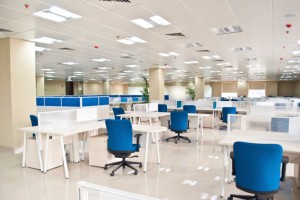
Contributor, Online Career Tips
With open office layouts gaining popularity, cubicles may be a thing of the past. With companies looking for more interoffice connections and teamwork-driven projects, an open office seems like the best, most effective design. While this work place phenomenon is changing the way offices are run, it may not be the best design. Read on to find out why open offices work well and ways in which they fall short to the cubicle.
Why Open Offices Work
With highly successful companies like Google and hip new start-ups alike choosing to go with an open office layout, there must be many benefits that come with this design.
Collaboration
Businesses and corporations which thrive on high levels of team work and collaboration often find open offices to be the most conducive layout. This allows colleagues to freely bounce ideas back and forth without having to travel far or shout over a cubicle. Also offices designed without walls and obstacles let employees move chairs, furniture, and laptops in order to form collaborative groups with ease.
Communication
With an open office layout, it’s easier than ever to communicate with colleagues. With the easy accessibility of other co-workers and supervisors you can communicate more efficiently and get things done faster. Also the amount of inconvenient interruptions by coworkers decreases in this type of setting, as all employees are able to see if whom they wish to speak with is busy on the phone, engrossed in work, or is available for a conversation.
Safety
In every workplace, safety should be at the pinnacle of importance of an office layout and the design of an open office is no exception. Without visual blockages, such as half walls and individual offices, employees can more easily see hazards like a fire or chemical leak. Also an open office design is perfect for a smoke evacuation system, which will definitely help to keep your employees safe.
Environment
The design of an open office is an overall more cohesive environment conducive to efficient work and high productivity. While cubicles make an office feel stuffy and segmented, offices without dividing walls can help ideas flow freely and help teams work together better.
The Downside to an Open Office Layout
While this office layout has risen to popularity seemingly overnight, it does still have some problems that have companies rethinking this design.
Collaboration
In many offices employees must balance collaborative efforts with individual tasks. In an open office set up for constant collaboration, solo work may fall by the wayside or be less precise.
Communication
While open office layouts give employees the ability to communicate freely, it may be too much communication to work effectively. Employees who work best in quiet spaces will find it hard to concentrate on this kind of environment and in turn won’t create quality work.
Safety
During cold and flu season an open office layout can become a safety nightmare. Unless all employees wear masks and rubber gloves, catching a seasonal illness or passing it along can be almost inevitable in this kind of environment.
Environment
While some employees will thrive in an open office layout, others who still need their own privacy and personal space may have trouble concentrating in an open office design. Also, the noise and distractions that come with this community environment can be highly distracting.
When choosing the design for your office, it’s important to think about what will make your work place run best. Whether your business is highly collaborative and communication-heavy or focused on more individual work may help you choose the most advantageous layout for your work place. As always when making a big company decision, weigh your options, think about your employees and make the choice that will help your company succeed.

Comments are closed.